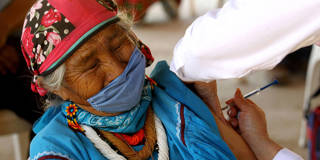The current approach to COVID-19 vaccination – using limited vaccine supplies to protect low-risk populations in a handful of countries while low- and middle-income economies wait indefinitely for doses – doesn’t make sense for anyone. A successful global vaccination effort must be equitable, and it must stand on three pillars.
WASHINGTON, DC – The COVID-19 pandemic will not truly end until everyone has access to vaccines, including people in the poorest countries. Worldwide vaccination offers the best hope for stopping the spread of infections, saving lives, and protecting livelihoods. People cannot reach their potential until they can again study, work, travel, and socialize in the confident knowledge that they are safe from COVID-19.
Distributing vaccines more widely is thus an urgent necessity. The pandemic has worsened inequality by hitting the poorest and most vulnerable the hardest. In developing countries, women, children, the poor, and informal-sector workers have paid an extremely high price as COVID-19 took away livelihoods, closed classrooms, and prevented urgent social spending.
Delays in starting vaccination rollouts in developing countries are deepening global inequality and leaving hundreds of millions of elderly and vulnerable people at risk. I continue to urge countries with sufficient vaccine supplies to release their additional doses as soon as possible to developing countries that have delivery programs in place.

WASHINGTON, DC – The COVID-19 pandemic will not truly end until everyone has access to vaccines, including people in the poorest countries. Worldwide vaccination offers the best hope for stopping the spread of infections, saving lives, and protecting livelihoods. People cannot reach their potential until they can again study, work, travel, and socialize in the confident knowledge that they are safe from COVID-19.
Distributing vaccines more widely is thus an urgent necessity. The pandemic has worsened inequality by hitting the poorest and most vulnerable the hardest. In developing countries, women, children, the poor, and informal-sector workers have paid an extremely high price as COVID-19 took away livelihoods, closed classrooms, and prevented urgent social spending.
Delays in starting vaccination rollouts in developing countries are deepening global inequality and leaving hundreds of millions of elderly and vulnerable people at risk. I continue to urge countries with sufficient vaccine supplies to release their additional doses as soon as possible to developing countries that have delivery programs in place.